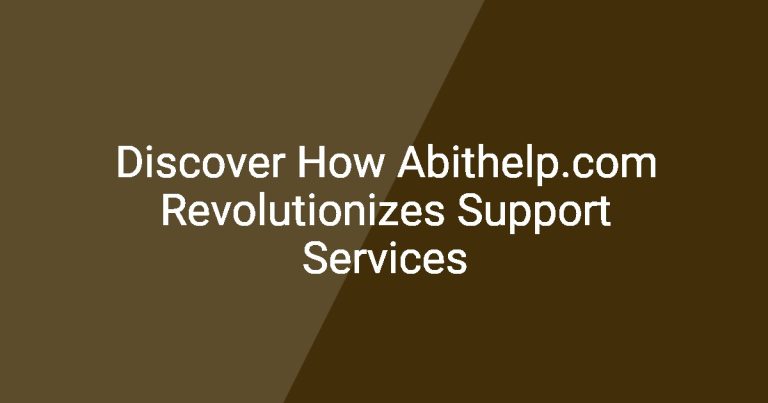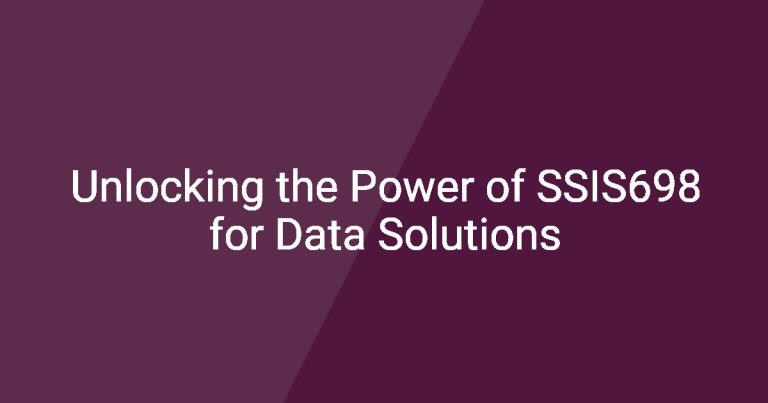As organizations increasingly rely on data-driven decision-making, having an efficient data integration tool is more crucial than ever. Enter SSIS858, a powerful enhancement within SQL Server Integration Services (SSIS) that addresses the challenges of modern data workflows. Understanding SSIS858 can significantly impact how businesses manage and migrate their data, improving efficiency, ease of use, and overall performance.
Introduction to SSIS858
What is SSIS858?
SSIS858 is an advanced version of SQL Server Integration Services that provides robust data integration capabilities. It operates within the larger framework of SSIS, designed to facilitate the extraction, transformation, and loading (ETL) of data. This version incorporates enhancements that address previous limitations, enabling users to engage in efficient data management across diverse systems.
Importance of SSIS858 in Data Integration
The role of SSIS858 in data workflows cannot be overstated. With the ability to handle complex ETL scenarios, this version streamlines data migration and transformation tasks, reducing the time and effort required for such processes. The benefits of utilizing SSIS858 include improved data integrity, faster processing times, and the ability to integrate more diverse data sources seamlessly.
Key Features of SSIS858
Enhanced Performance Metrics
One of the most compelling reasons to adopt SSIS858 is its enhanced performance metrics. Compared to previous versions, SSIS858 boasts significant speed improvements, allowing organizations to process larger datasets in less time. Resource optimization techniques further ensure that the utilization of memory and CPU resources is at its peak, resulting in lower operational costs.
User-Friendly Interface
The user-friendly interface of SSIS858 makes it accessible to users with varying levels of expertise. Its design emphasizes usability, featuring customizable options tailored for different user roles—from novice data analysts to expert developers. This means that organizations can adopt SSIS858 across teams without a steep learning curve.
Support for Advanced Data Types
SSIS858 supports a variety of advanced data types, including JSON and XML. This capability allows for greater flexibility in data integration since organizations can connect to a wider array of data sources. Additionally, SSIS858 offers integration options that facilitate working with other data formats, broadening the scope of data manipulation possibilities.
How to Implement SSIS858
System Requirements
Before diving into implementation, it’s essential to gauge the system requirements for SSIS858. The hardware prerequisites often include a multi-core processor, sufficient RAM (8GB or more recommended), and adequate disk space. Software-wise, SSIS858 typically requires Windows Server 2016 or later and is compatible with SQL Server 2016 and upwards, making it vital to assess your organization’s existing infrastructure before installation.
Installation Process
Installing SSIS858 involves several steps:
- Download the installation file from the official Microsoft website.
- Run the installer and follow the on-screen prompts.
- Upon completion, configure the necessary settings, such as setting up connections and user access privileges.
Post-installation configuration is crucial for ensuring that SSIS858 operates optimally within your infrastructure.
Basic Setup for Data Projects
Setting up a new data project in SSIS858 begins with launching the Integration Services project template. Users can then:
- Define data sources by selecting databases, file systems, or web services.
- Design data transformation flows with built-in tools and components.
- Specify destinations for the processed data, whether it’s another database, file, or cloud service.
This high-level overview of the project setup allows data professionals to harness the full potential of SSIS858 rapidly.
Common Use Cases for SSIS858
ETL Processes
SSIS858 shines brightest in ETL processes, which involve the extraction, transformation, and loading of data from one system to another. Organizations use SSIS858 to automate routine ETL tasks, ensuring high-speed data movement and reliability. For example, a retail company may extract sales data from multiple outlets, transform it to match its centralized reporting structure, and load it into a data warehouse for analysis.
Data Warehousing Implementation
The ability of SSIS858 to facilitate data warehousing implementations is noteworthy. Through its advanced ETL capabilities, SSIS858 allows businesses to consolidate data from various sources, creating a single repository for analysis and reporting. Case studies indicate that firms leveraging SSIS858 often report reduced reporting times and improved business intelligence outcomes.
Real-time Data Integration
SSIS858 also supports real-time data integration, crucial for organizations needing instantaneous data updates. This contrasts with batch processing, where data is collected and processed at designated intervals. By utilizing features of SSIS858, businesses can implement tools and techniques for real-time integration, such as change data capture, ensuring their data stays current and responsive to market fluctuations.
Troubleshooting Common Issues in SSIS858
Common Errors and Warnings
- Reviewing the error logs for specific messages.
- Verifying database connectivity and configurations.
- Utilizing built-in debugging tools to track data flow errors.
Performance Tuning
To ensure optimal performance of SSIS858, techniques for performance tuning can be employed. Strategies may include:
- Optimizing data flow paths to minimize bottlenecks.
- Employing parallel processing for larger datasets.
- Utilizing monitoring and logging tools to gain insight into performance metrics.
Best Practices for Using SSIS858
Data Validation Techniques
Data quality is paramount when utilizing SSIS858. Implementing data validation techniques such as checking for null values, verifying data types, and ensuring referential integrity can help maintain high data quality. Using tools integrated with SSIS858, users can automate these checks to enhance efficiency.
Version Control Strategy
Managing version changes in SSIS858 projects is critical, especially in collaborative environments. Implementing a version control strategy that involves regular commits and clear documentation of changes ensures that all team members are aligned. Collaboration best practices—such as regular review meetings and shared documentation—can foster successful teamwork.
Documentation and Maintenance
Keeping documentation up-to-date is crucial when working with SSIS858. Establishing a documentation strategy that includes system architecture, ETL procedures, and troubleshooting guides can save significant time and effort in the long run. Regular maintenance of SSIS858 packages will further ensure that they remain performant and relevant.
Conclusion
Recap of SSIS858 Benefits
In summary, SSIS858 offers numerous advantages, including enhanced performance, user-friendliness, and extensive support for various data types. Its successful implementation can lead to improved data workflows and better decision-making processes within organizations. The future of SSIS858 looks promising as its capabilities expand to meet evolving industry demands.
Call to Action
For organizations seeking to streamline their data integration processes, exploring SSIS858 is a step in the right direction. To gain deeper insights, consider checking resources like the official Microsoft documentation and community forums for additional guidance.
Additional Resources
Official Documentation and Tutorials
Utilizing official documentation is vital for maximizing the functionality of SSIS858. Microsoft provides extensive documentation, including step-by-step tutorials, system requirements, and troubleshooting guides. For interaction and support, consider joining forums and user groups that focus on SSIS development.
Recommended Tools and Add-ons
Several tools can enhance the functionality of SSIS858, including third-party plugins that add new features and capabilities. Tools like KingswaySoft or SSIS Integration Toolkit for Salesforce offer additional integration options that can be beneficial when combined with SSIS858.
| Feature | Description |
|---|---|
| Performance Improvements | Significant speed enhancements and resource optimization techniques. |
| User-Friendly Interface | Customizable layout to suit varying user skill levels. |
| Advanced Data Type Support | Supports JSON, XML, and other diverse data formats. |
| Real-Time Integration | Facilitates quick updates of data using techniques like change data capture. |
| Data Warehousing | Streamlines data consolidation for improved business intelligence. |
FAQs
1. What is the main functionality of SSIS858?
SSIS858 primarily focuses on data integration through ETL processes, helping organizations automate and streamline data flows.
2. Can I run SSIS858 on older versions of SQL Server?
No, SSIS858 requires SQL Server 2016 or later. It’s important to ensure compatibility with your current system.
3. What types of data can SSIS858 handle?
SSIS858 supports various advanced data types, including JSON and XML, making it versatile for different integration needs.
4. How does real-time data integration work in SSIS858?
This feature allows data to be updated as it changes in the source system, enabling timely insights and analytics.
5. What are common issues with SSIS858, and how can they be resolved?
Common issues include connection errors and data type mismatches. Reviewing error logs and ensuring proper configurations can help resolve these.
6. How can I optimize performance in SSIS858?
Utilizing parallel processing, monitoring tools, and optimizing data flows are effective ways to enhance the performance of SSIS858.
7. Is there a community support system for SSIS858 users?
Yes, there are several community forums and groups where users can share insights, ask questions, and discuss best practices.
8. What are some best practices for documentation in SSIS858?
Maintaining thorough documentation of ETL processes, system architecture, and any changes made to SSIS packages is critical for ongoing success.
9. How does version control affect SSIS858 projects?
Implementing version control helps manage changes, ensures team alignment, and facilitates better collaboration among team members.
10. Why is data validation important in SSIS858?
Ensuring data quality through validation checks is essential for reliable data processing and analysis in any data integration scenario.







